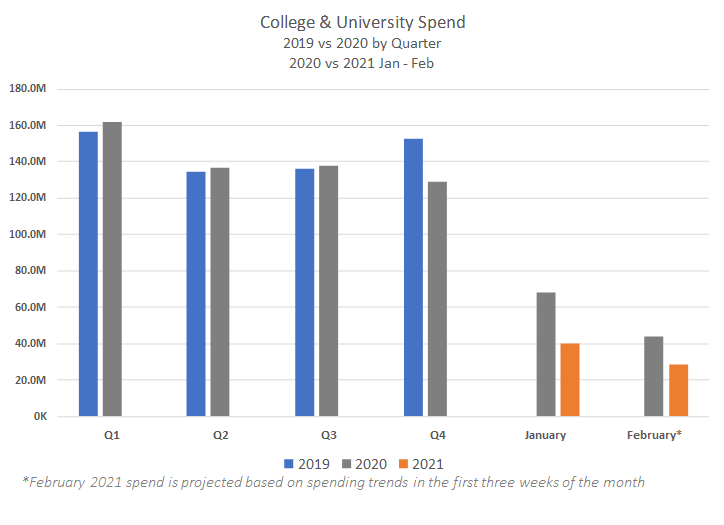Many colleges, especially small liberal arts schools, struggled with finances last year. At the same time, the traditional admissions process went through big changes.
These pandemic-related challenges impacted how colleges recruit students and how much they spend on advertising. We can’t say these trends are causing a significant drop in spend—but they are what the industry is grappling with at the same time.
And we do know who the top higher-education spenders are and how much are they spending.
We encourage you to subscribe to our blog for the latest data surrounding the advertising industry. We will provide daily updates as COVID-19 continues to make its mark on the US economy.

Virtual Tours Change Recruitment
When college campuses began shutting down due to the pandemic in spring of 2020, it wasn’t only current students and faculty tackling a change of plans. Prospective students and their families also found themselves canceling plans for campus visits.
While virtual tours were already available at many schools, they were clunky.
Previously, online visits “didn’t look so good and they’ve never looked so good,” Sarah Harberson, author of Soundbite: The Admissions Secret That Gets You Into College and Beyond, said. “But I think over the next year, you’re going to see colleges get more and more creative.”
Colleges are currently investing in this technology, even as they grapple with lower application counts. Ideally, this capability will save admissions teams money down the line when officers don’t need to travel as extensively.
Social Distancing Changes Testing Requirements
Another common part of the college preparation process for high schoolers is to take major standardized tests, including the SAT, ACT, and AP subject tests.
Due to health and safety concerns, it became nearly impossible to proctor such exams in-person.
In 2020, the hours-long AP exams were compressed into 45-minute open-book exams taken via a variety of virtual devices. Now, the College Board promises “unprecedented flexibility” in the 2021 testing setup, which will include both in-person and digital options.
The College Board also did away with the optional essay portion and subject tests of the SAT, streamlining and standardizing the exam in an attempt to lessen the financial blow of the test.
At the same time, many universities have, at least temporarily, removed their standardized testing requirements to cater to students heavily affected by the pandemic. At least three-quarters of colleges and universities did not require applicants to provide scores from the SAT or other standardized tests in fall 2020, and many already have plans to continue this freeze for several years.
Changes in Application Requirements Causes Applications to Surge at Prestigious Schools, But Go Silent at Less-Known Schools
Perhaps due to the lack of standardized testing requirements, prestigious universities are receiving more applications than ever, especially from those who previously thought they wouldn’t get in.


Others, however, are seeing a marked decrease in the number of applications received. Cal Poly Pomona—a highly ranked public school—even started calling students who’d abandoned their application or who’d applied in the past and weren’t granted admission.
Many students, especially those from lower income brackets, have decided to defer or forego their college plans until they can offer a higher return on investment. In some cases, they see an all- or mostly-virtual class load as less worth their time and money.
These smaller schools face the potential financial ramifications of having too few paying students to pay faculty and staff. Some have already been forced to close.
MediaRadar Insights
While the institutions themselves were affected much earlier, ad spend by colleges and universities didn’t start to reflect the changes brought on by the pandemic until Q4 of 2020. Historically, colleges and universities tend to increase ad spend by 20% between Q3 and Q4. In 2020, however, the industry saw a 7% decrease in spend during that time.
So far in 2021, a total of 2.1k college and university brands have spent $58 million in advertising across all platforms (TV, digital, and print). This is a 40% YoY decrease.

The top brands in 2021—Southern New Hampshire University, Phoenix University, Capella, Western Governors University, and Grand Canyon University—were consistent with the previous three years.


However, even though they’re still the top advertising brands within their category, their ad spend has decreased significantly so far this year.
For more updates like this, stay tuned. Subscribe to our blog for more updates on coronavirus and its mark on the economy.



